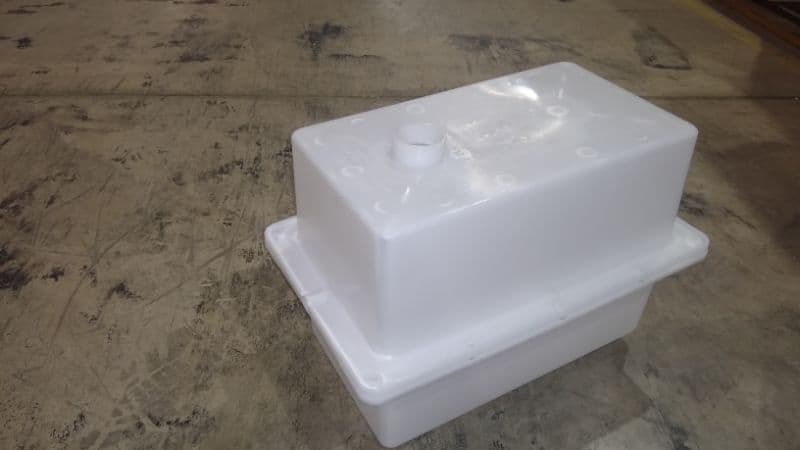Can batteries be installed inside an RV?
- No, lead-acid batteries cannot be installed inside an RV without being inside an approved battery box vented to the outside.
- Yes, lithium batteries can be installed inside an RV without special equipment.
Is It Dangerous to Place Batteries Inside of an RV?
The location of batteries inside your RV is governed by the ANSI/RVIA LV: Standard for Low Voltage Systems in Conversion and Recreational Vehicles. Chapter 2:3 states:
If vented batteries (includes lead acid and sealed lead acid) or vented battery compartments are provided, the battery compartments shall be vapor resistant to the interior and ventilated directly to the exterior of the vehicle.
-ANSI/RVIA LV Standard
Layman’s translation: No, you can’t place a lead-acid battery inside an RV unless it’s inside a vented battery box ventilated to the outside. Emphasis on “lead-acid;” rules for lithium batteries are different.
This is because lead-acid batteries can generate hydrogen gas, which is explosive at certain concentrations in air. Ka-boom.
It’s tempting to downplay the danger of explosive battery gas. After all, exploding batteries are so rare they normally make headlines! However, while the frequency is low, the risk is high. Battery explosions cause thousands of eye and skin injuries every year.
What Type of Vented Battery Should Should I Use?
Now, the description “vented battery box” has caused some confusion, since many battery boxes have little louver vents. That’s not what I’m talking about. Here’s what a “vented battery box” looks like:

And not to split hairs, but some people phrase the question a bit differently: Is it hazardous to use a lead-acid battery inside a camper?
This question is commonly asked when someone wants to use a portable battery to power a CPAP machine, and the battery will be removed from the RV during actual charging.
This concern is not addressed by code. IMHO, I would not have a personal problem temporarily using a lead-acid battery inside an RV so long as I had A) double-checked the battery was in good health and B) removed the battery from any short-circuiting elements or sparking equipment.
Do Lead-Acid Batteries Off-Gas?
Off-gassing causes a lot of confusion. In ye olde times, battery off-gassing was more common. Primitive battery chargers often overcharged batteries, which caused the electrolyte to boil and release hydrogen gas. Thankfully, modern battery chargers rarely overcharge batteries. However, we should err on the safe side and plan for the possibility.
There are several types of lead-acid batteries. The two most popular options in RVs are flooded (aka wet) and AGM (absorbed glass mat).
- Flooded lead-acid batteries are your typical deep-cycle house battery, common on RVs for decades. You’re supposed to check the electrolyte levels every so often and top off with distilled water.
- AGM batteries are usually a type of Sealed Lead Acid (SLA) or Valve Regulated Lead Acid (VRLA) battery. The electrolyte cells are sealed, so no maintenance is required.
Don’t let the acronyms scare you! Wet, flooded, AGM, gel, VRLA, SLA – all descriptions applied to different types of lead-acid batteries. And because essentially any lead-acid battery could off-gas, none can be installed willy-nilly inside of an RV. A hose must be installed to carry any dangerous gases into the outdoors.

Do AGM Batteries Off-Gas?
Just in case you breezed over that last section … yes, AGM batteries can off-gas dangerous fumes as well!
It’s a common misconception to assume that Sealed LA batteries (sometimes sold as “maintenance-free” batteries) are exempt from venting requirements, but that’s not true.
In the typical charging cycle, an VRLA-AGM battery uses recombinant technology to keep the electrolyte captive. But if overcharged and overpressurized, an AGM battery could blow off steam, as it were. That’s the potential danger, and that’s why AGM batteries are not allowed to be installed in non-vented locations.
Can I Install Lithium Batteries Inside My Camper?
Yes, you can! This is one reason lithium batteries have rapidly become the Prom Queen of RV electrical upgrades: They can be installed almost anywhere!
(As long as they don’t freeze, that is. Remember: Lithium batteries are comfortable at the same temperatures you are.)
Lithium batteries do not require vapor-resistant compartments or containers. They can be installed in cabinets very easily.
… But What If I Can’t Afford Lithium Batteries?
If you don’t want to upgrade to lithium batteries, just install your lead-acid batteries inside of an approved vented battery box. You’ll need to cut a hole in your sidewall and install a vent, like this:

But if you’re upgrading 2, 3, or 4 batteries, you probably don’t want to cut 2, 3, or 4 holes in your sidewall! What’s the best solution?
Unfortunately, I don’t know of any mass-market RV-friendly battery boxes designed for 3 or more batteries. (Send me an email if you know of any.) RV owners must cobble together their own – and thankfully, you RV guys are impressively handy! For instance, this gentlemen vented a heavy-duty storage tote. (I’m not signing off on his design, just pointing out some DIY options. You’ll need to validate your own design.)
Leave a Reply